This one dips, dives, and wanders a bit. A few updates I stumbled across last week indicate that Strava is probably ramping up programmatic SEO efforts and trending toward a product shift that supports improved search and discovery. It’s a dive into product challenges, search, SEO strategy, and more. But, I also stumbled into the answers to a few interesting questions like “whatever happened to all that FATMAP route data”, and “Why did Strava remove links from the app?”.
Let’s set the stage
Strava is primarily known for activity tracking, performance analysis, and a social feed; its strengths are rooted in data and community. However, one area where they lag is search and discovery. Sure, you can build routes manually, see some ‘community routes’ on mobile, or utilize an ‘auto route builder’, but compared to other platforms, Strava’s discovery options are sparse. Their map feature on both web and mobile is notoriously poor. They have a ton of data, but it’s not structured in a way that is useful for search and discovery. Ten thousand random Strava segments overlaid on a map are confusing to most users and make discovery a huge pain in the ass – especially if what you’re looking for is a named, local loop or identifiable trail (or a straightforward list view). The map is simultaneously pretty cool, and hard to use for many use-cases. That said, the heatmaps have been improving (you can now search heatmaps across most activity types).
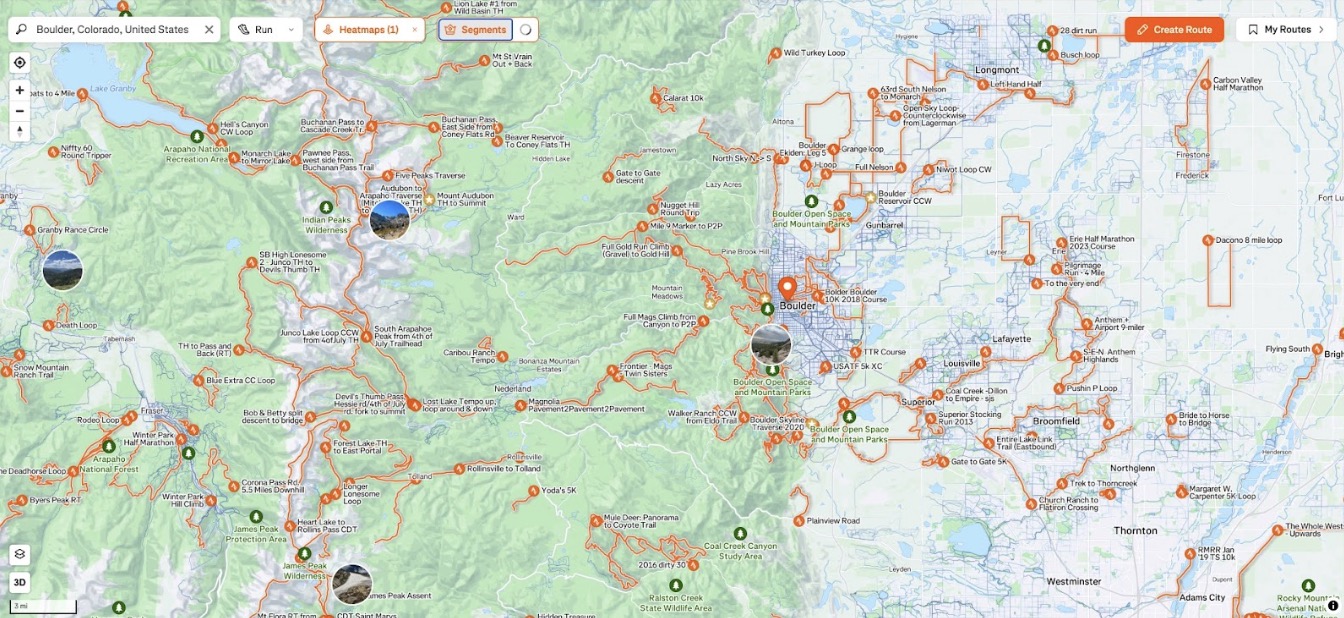
As an example, the “Dirty Bismark Loop” outside Boulder is a popular training loop for runners. It has at least 27 separate Strava segments, like “little climb”, “Cut loose”, and “One more wheee!”. Mount Sanitas has so many segments overlaid its impossible to know what you’re clicking on the map. Unstructured data like that is a nightmare for building a more accessible search experience with standardized “trail” information.
Ok, get to the point
Somewhat by accident, I stumbled across a few of Strava’s new SEO optimized pages via Google while researching backcountry skiing routes in Scotland. Naturally, I dug in a bit more (maybe too much). While Strava.com/routes and associated hiking pages have been around for a while, in late October 2024 there was a significant spike in the number of pages listed under that subdirectory. The root landing page was updated with additional locations, and additional activity types like backcountry skiing, climbing, trail running, and mountain biking were added – all formatted under Strava.com/routes/[activity]/region/location. Unsurprisingly, these location landing pages follow the same formula as the other programmatic pages I’ve worked on at previous startups (or you might see on Alltrails, Hipcamp, The Dyrt, etc). It’s clear that by competing with dynamic, search-optimized pages that cater to user search intent—like “best hikes near me” or “top backcountry routes in Chamonix”—Strava hopes to expand their reach and drive significant organic traffic.
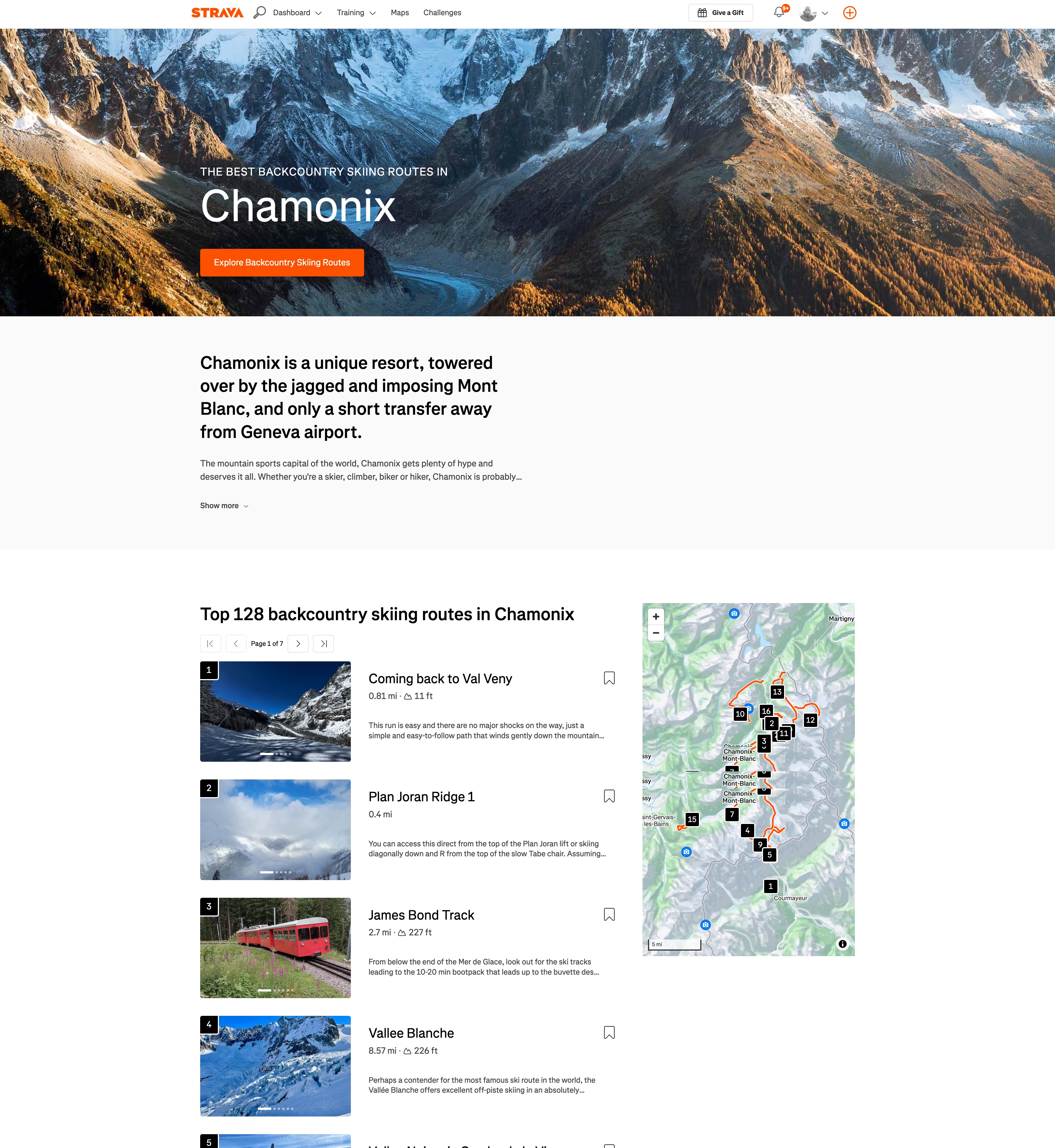
Some of the routes listed feel much more “standardized” than I’m used to seeing on Strava, particularly in search. They’ve likely used a combination of human brute force, aggregate data analysis from heat maps, and AI to land on more standardized routes, names, and route descriptions. The descriptions are surprisingly quite thorough, and I didn’t even know you could add descriptions to routes. They already have a ton of on-trail photo data, so photos can automatically be pulled in to these “new” routes. Strava’s substantial domain authority means that many of these newer routes are already starting to compete for top search spots. If you don’t want your Strava activity photos getting pulled into route pages (they appear unlinked and uncredited), you can make sure of that in your settings.
Additionally, they’ve de-listed a massive amount of old custom routes from Google, around 53k, if I’m not mistaken. One of the hallmarks of a good SEO strategy is a focused one. You want your “SEO juice” focused on the high-quality, high traffic pages, and this was probably an effort to remove (from indexing) a significant number of duplicate and one-off ‘routes’ created by users in favor of a more ‘approved’ set of standardized pages getting crawled by Google. Basically, getting rid of low value pages so that crawler bots will spend more time on the high value ones.

A decrease in indexed /routes urls, starting in late October.
Where’s all the FATMAP data?
In 2023, Strava acquired FATMAP, a mapping platform specializing in high-resolution 3D maps. In addition to high quality maps and advanced features tailored to the backcountry community, FATMAP had a library of searchable outdoor routes (particularly across Europe). Previous FATMAP users have expressed frustration with the lack of integration of advanced features into Strava over the last year-plus; it now seems possible that the acquisition was also a way to access a bunch of structured backcountry route data as well.
While I can’t give you a timeline for improved map layers, it seems all of FATMAP’s route data is now in Strava. Many of these new routes are activity types less commonly found on Strava…and many descriptions credit FATMAP (or users previously associated with FATMAP). You still can’t search for these routes in the app or on the web, and they’re currently only really accessible via Google. If you had public FATMAP routes you contributed to, you can probably find it by Googling your name + route + Strava (or backcountry skiing + [region of Europe] + Strava). It remains a bit confusing since most of these routes are ‘Written by [person]’ and created by ‘Strava Routes’, or not ‘created by’ anyone at all. I wasn’t able to reliably tell which ones may have previously existed on Strava vs being imported from FATMAP. I think all the ‘created by Strava Routes’ ones are imports since they were unable to the creator to a Strava account.
None of this should come as a surprise. Strava communicated that this would happen eventually, but folks are rarely happy with the development cadence of large software companies. Big, legacy codebases take a long time to change.
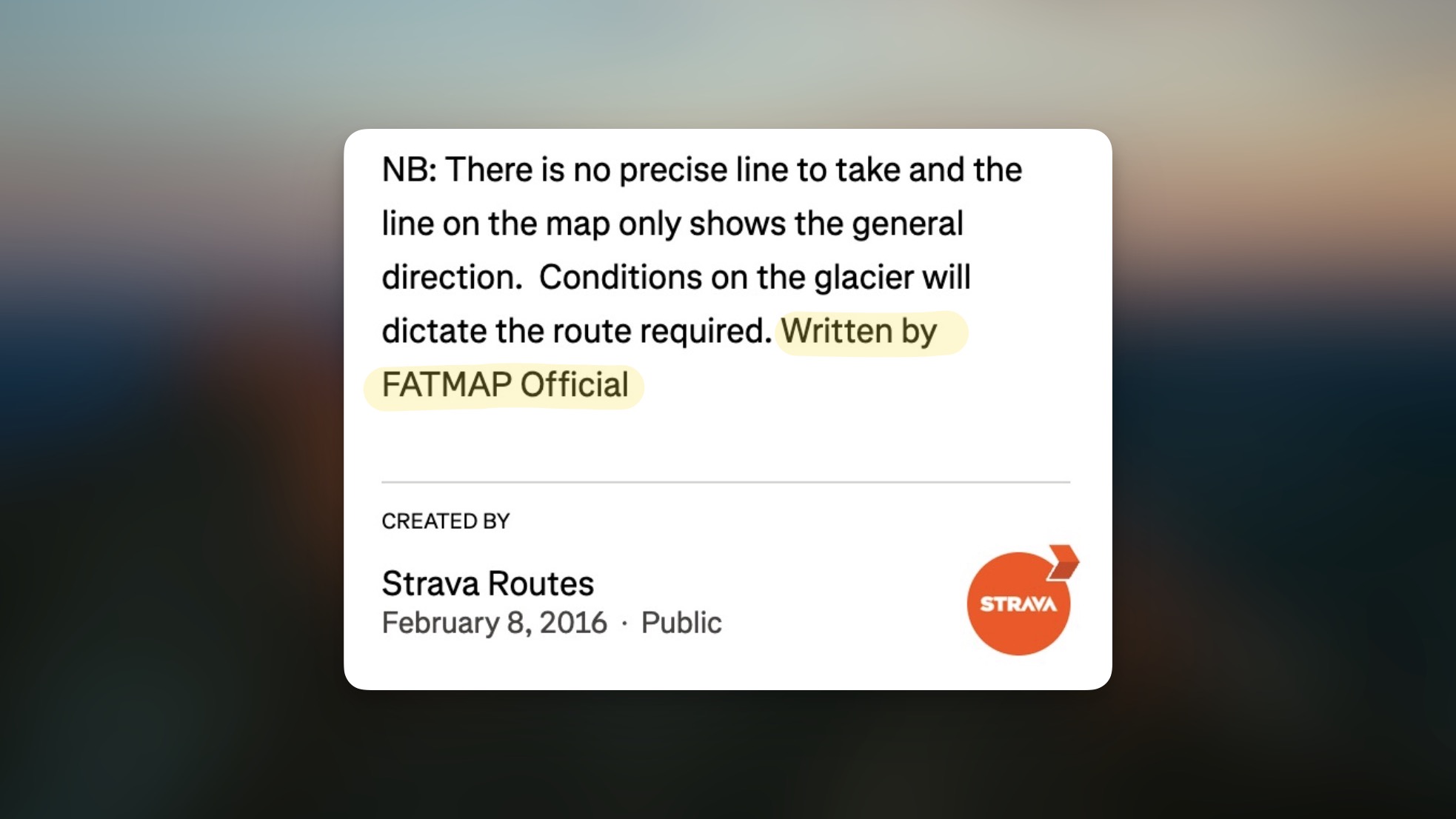
What happened with the hyperlinks?
While diving into the data, another massive drop in indexed urls (around 500k 😮) on Strava.com drew my attention. It took a bit of research, but I think I’ve zeroed in on the root cause. In October there was a minor hullabaloo and more than one Linkedin hot take when Strava removed hyperlinks from club pages (which broke a few other things) without explanation. Around the time this happened, I posited that it was likely a “broad stroke” crackdown on spam, and therefore a decision made in urgency and necessity, not “technical incompetence” as some online critics were espousing.
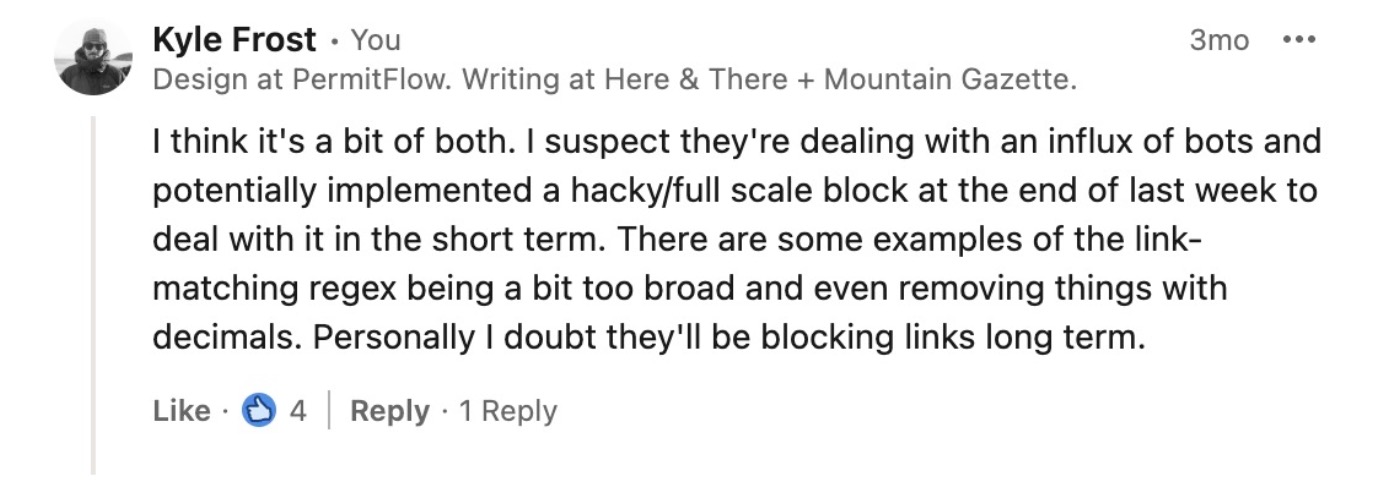
It turns out that it likely was a huge crackdown on spam. Around the same time this happened, nearly 600k Strava urls were removed from search engines. Now, these urls don’t exist anymore, but you can still see the keywords that they were ranking for. Spammers were using Strava clubs, activities, and post features to promote links to spam, video-sharing sites, and rank for less-than-savory search terms. It is a common spammer tactic to piggyback on the domain authority of big sites in order to get links to rank highly for certain search terms. Let me be clear–this is not a Strava failure. For all major user generated content (UGC) sites, the back-and-forth battle with spammers is a challenging and never-ending one. Every UGC site I’ve ever worked on has dealt with this in some way or another. Spammers are annoying, persistent, and creative. All signs point to a massive spam increase in September/October and the engineering team successfully addressing the issue.
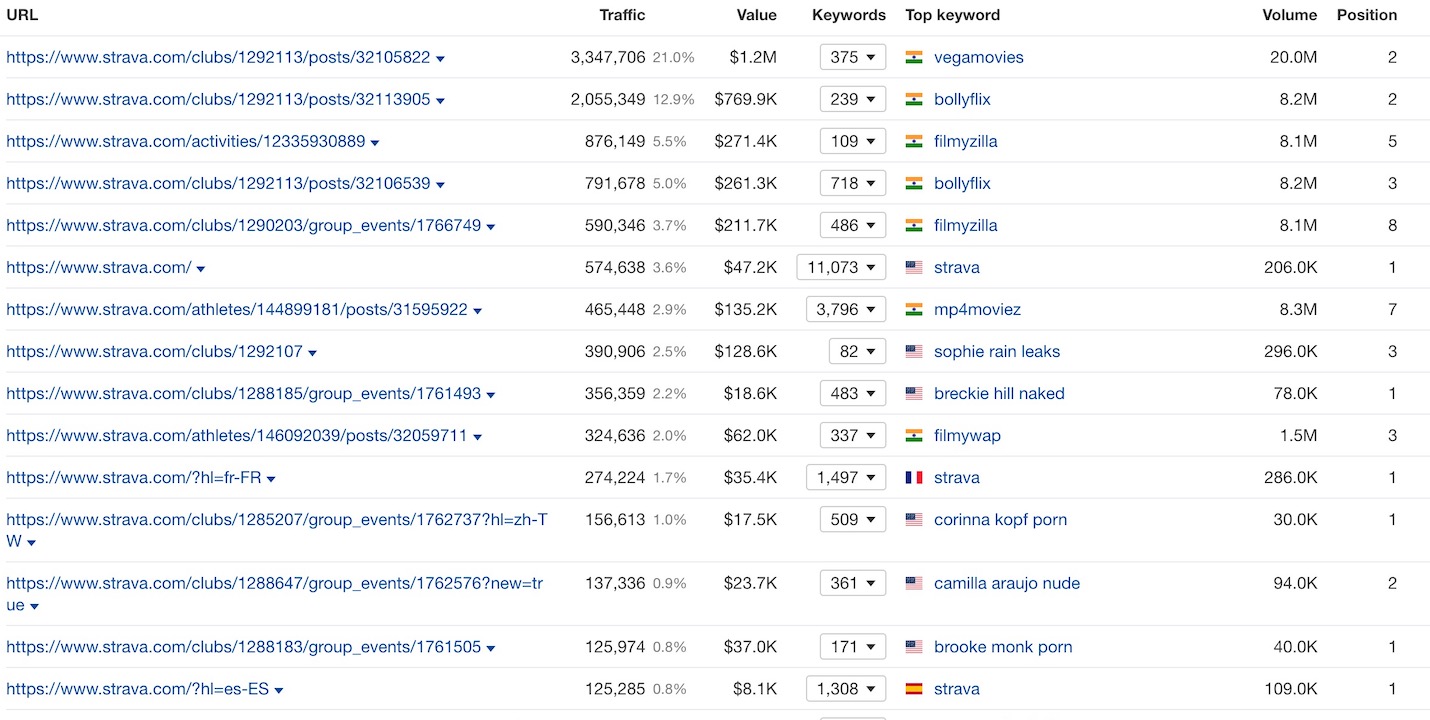
A few of the highest traffic removed pages from Strava (left) and the keywords they were ranking for in Google (right).
What does this all mean for Strava
The ramp-up in SEO-friendly route pages suggests that Strava is doubling down on discoverability. These new pages don’t (currently) serve users who are already on the platform; they’re a top-of-the-funnel acquisition and marketing tool, drawing in new audiences searching for routes in specific areas. While there’s little to no connectivity between these pages right now, I would be shocked if this isn’t the precursor to a more user-friendly search experience on web and mobile. There’s little reason to spend the time on this if you don’t eventually plan on connecting it all together somehow. While discovery isn’t the only direction Strava could head, I think it’s the one they’re currently the most likely to place resources behind.
Discovery and down-market - Attracting additional down-market consumers through better discovery, and more casual hike/run activity usage. I could also see a beginner friendly training experience being developed (a la Runna).
Advanced tracking, power users - Double down on advanced features, detailed training, coaching, and activity logging a la Training Peaks. While many think this is a direction Strava should go, this feels unlikely to me.
Products and ads - They know your gear, they know when you might need to replace it. Why not buy through Strava (or, at least get served relevant ads).
If it continues to play out, the strategy mirrors what other companies have been doing for years: offering free, limited, access to a library of routes (discovery) while nudging users toward signup or a paid tier (tracking + training?). If you find you’ve found a hike that piques your interest on Strava.com, the next logical step might be to sign up, download it to Strava, track it on Strava and share it on Strava. And then… hopefully upgrade. This side of SEO is something Strava has long struggled with because random activity and segment names aren’t things that people are typically searching for, but they’re obviously investing in improvements.
I think Strava is going to take a shot at capturing discovery and more casual hike/run/outdoor tracking market, and those users want clean, clear, discoverable options. My prediction would be that we see a significant redesign of maps and search on Strava (web and mobile) in 2025. However, given the amount of features already packed into the Strava app, I’ll be curious how this gets accomplished – both on web and mobile. Shoehorning a first-class discovery experience into the existing app will be a challenge – Strava has always been social-first, whereas apps like Alltrails and OnX are discovery-first.
What’s next
AllTrails, OnX and others will be paying attention. AllTrails has long dominated the space for hikers and outdoor enthusiasts, offering a clean and user-friendly library of trails across the globe. Their app is well designed, and they won an Apple Design Award in 2023. OnX has put investment behind being the best “backcountry” app–something Strava seems to want to take a bite out of with the intergration of FATMAP routes. It’ll be interesting to see how more integrated discovery features will both affect Strava’s new user acquisition, and the loyalty of its current userbase. If I’m right (and I certainly might not be), I’ll be curious to see what a more “accessible” and search-friendly Strava looks like, and how that affects long-time power users.



